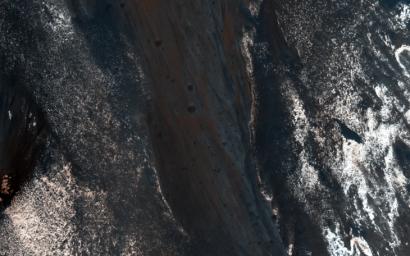
|
Slope Lineae along Coprates Chasma Ridge
- Click the image above for a larger view
- Full-Res JPEG (2880 x 1800) (862.3 kB)
- Full-Res TIFF (2880 x 1800) (15.6 MB)
Caption:
The formation of "recurring slope lineae" is a fascinating process on Mars that we're just beginning to investigate, and one that has been imaged before in Palikir Crater .
These RSLs show up in the spring and fade in the winter. Their presence might be due to briny water, and it opens up the door to taking a fresh look at other possible RSL candidates. This observation was done to accomplish just that: to re-image a previously photographed area that might confirm if this a candidate for RSL.
When HiRISE re-images an area, we try to match the exact lighting as before, in order to see any differences. Along with a stereo pair and resulting anaglyph, our understanding of the terrain is more complete.
Background Info:
HiRISE is one of six instruments on NASA's Mars Reconnaissance Orbiter. The University of Arizona, Tucson, operates the orbiter's HiRISE camera, which was built by Ball Aerospace & Technologies Corp., Boulder, Colo. NASA's Jet Propulsion Laboratory, a division of the California Institute of Technology in Pasadena, manages the Mars Reconnaissance Orbiter Project for the NASA Science Mission Directorate, Washington.
Cataloging Keywords:
| Name | Value | Additional Values |
|---|---|---|
| Target | Mars | |
| System | ||
| Target Type | Planet | |
| Mission | Mars Reconnaissance Orbiter (MRO) | |
| Instrument Host | Mars Reconnaissance Orbiter | |
| Host Type | Orbiter | |
| Instrument | High Resolution Imaging Science Experiment (HiRISE) | |
| Detector | ||
| Extra Keywords | Color, Crater, Water | |
| Acquisition Date | ||
| Release Date | 2013-09-03 | |
| Date in Caption | ||
| Image Credit | NASA/JPL-Caltech/Univ. of Arizona | |
| Source | photojournal.jpl.nasa.gov/catalog/PIA17648 | |
| Identifier | PIA17648 | |
